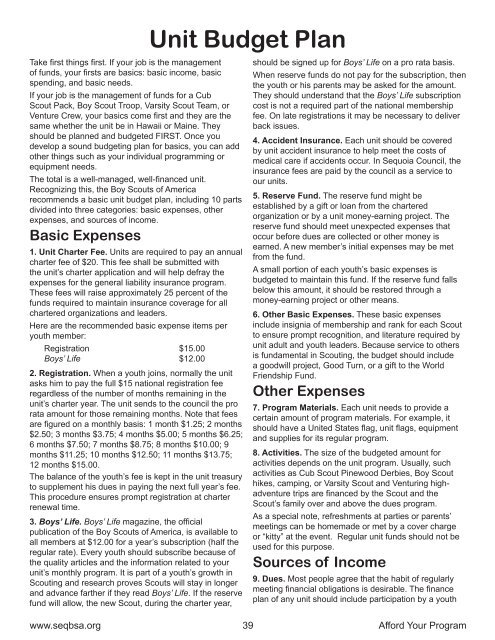2012-2013 Planning Guide - Sequoia Council Boy Scouts of America
2012-2013 Planning Guide - Sequoia Council Boy Scouts of America
2012-2013 Planning Guide - Sequoia Council Boy Scouts of America
Create successful ePaper yourself
Turn your PDF publications into a flip-book with our unique Google optimized e-Paper software.
Take first things first. If your job is the management<br />
<strong>of</strong> funds, your firsts are basics: basic income, basic<br />
spending, and basic needs.<br />
If your job is the management <strong>of</strong> funds for a Cub<br />
Scout Pack, <strong>Boy</strong> Scout Troop, Varsity Scout Team, or<br />
Venture Crew, your basics come first and they are the<br />
same whether the unit be in Hawaii or Maine. They<br />
should be planned and budgeted FIRST. Once you<br />
develop a sound budgeting plan for basics, you can add<br />
other things such as your individual programming or<br />
equipment needs.<br />
The total is a well-managed, well-financed unit.<br />
Recognizing this, the <strong>Boy</strong> <strong>Scouts</strong> <strong>of</strong> <strong>America</strong><br />
recommends a basic unit budget plan, including 10 parts<br />
divided into three categories: basic expenses, other<br />
expenses, and sources <strong>of</strong> income.<br />
Basic Expenses<br />
1. Unit Charter Fee. Units are required to pay an annual<br />
charter fee <strong>of</strong> $20. This fee shall be submitted with<br />
the unit’s charter application and will help defray the<br />
expenses for the general liability insurance program.<br />
These fees will raise approximately 25 percent <strong>of</strong> the<br />
funds required to maintain insurance coverage for all<br />
chartered organizations and leaders.<br />
Here are the recommended basic expense items per<br />
youth member:<br />
Registration $15.00<br />
<strong>Boy</strong>s’ Life $12.00<br />
2. Registration. When a youth joins, normally the unit<br />
asks him to pay the full $15 national registration fee<br />
regardless <strong>of</strong> the number <strong>of</strong> months remaining in the<br />
unit’s charter year. The unit sends to the council the pro<br />
rata amount for those remaining months. Note that fees<br />
are figured on a monthly basis: 1 month $1.25; 2 months<br />
$2.50; 3 months $3.75; 4 months $5.00; 5 months $6.25;<br />
6 months $7.50; 7 months $8.75; 8 months $10.00; 9<br />
months $11.25; 10 months $12.50; 11 months $13.75;<br />
12 months $15.00.<br />
The balance <strong>of</strong> the youth’s fee is kept in the unit treasury<br />
to supplement his dues in paying the next full year’s fee.<br />
This procedure ensures prompt registration at charter<br />
renewal time.<br />
3. <strong>Boy</strong>s’ Life. <strong>Boy</strong>s’ Life magazine, the <strong>of</strong>ficial<br />
publication <strong>of</strong> the <strong>Boy</strong> <strong>Scouts</strong> <strong>of</strong> <strong>America</strong>, is available to<br />
all members at $12.00 for a year’s subscription (half the<br />
regular rate). Every youth should subscribe because <strong>of</strong><br />
the quality articles and the information related to your<br />
unit’s monthly program. It is part <strong>of</strong> a youth’s growth in<br />
Scouting and research proves <strong>Scouts</strong> will stay in longer<br />
and advance farther if they read <strong>Boy</strong>s’ Life. If the reserve<br />
fund will allow, the new Scout, during the charter year,<br />
www.seqbsa.org<br />
Unit Budget Plan<br />
should be signed up for <strong>Boy</strong>s’ Life on a pro rata basis.<br />
When reserve funds do not pay for the subscription, then<br />
the youth or his parents may be asked for the amount.<br />
They should understand that the <strong>Boy</strong>s’ Life subscription<br />
cost is not a required part <strong>of</strong> the national membership<br />
fee. On late registrations it may be necessary to deliver<br />
back issues.<br />
4. Accident Insurance. Each unit should be covered<br />
by unit accident insurance to help meet the costs <strong>of</strong><br />
medical care if accidents occur. In <strong>Sequoia</strong> <strong>Council</strong>, the<br />
insurance fees are paid by the council as a service to<br />
our units.<br />
5. Reserve Fund. The reserve fund might be<br />
established by a gift or loan from the chartered<br />
organization or by a unit money-earning project. The<br />
reserve fund should meet unexpected expenses that<br />
occur before dues are collected or other money is<br />
earned. A new member’s initial expenses may be met<br />
from the fund.<br />
A small portion <strong>of</strong> each youth’s basic expenses is<br />
budgeted to maintain this fund. If the reserve fund falls<br />
below this amount, it should be restored through a<br />
money-earning project or other means.<br />
6. Other Basic Expenses. These basic expenses<br />
include insignia <strong>of</strong> membership and rank for each Scout<br />
to ensure prompt recognition, and literature required by<br />
unit adult and youth leaders. Because service to others<br />
is fundamental in Scouting, the budget should include<br />
a goodwill project, Good Turn, or a gift to the World<br />
Friendship Fund.<br />
Other Expenses<br />
7. Program Materials. Each unit needs to provide a<br />
certain amount <strong>of</strong> program materials. For example, it<br />
should have a United States flag, unit flags, equipment<br />
and supplies for its regular program.<br />
8. Activities. The size <strong>of</strong> the budgeted amount for<br />
activities depends on the unit program. Usually, such<br />
activities as Cub Scout Pinewood Derbies, <strong>Boy</strong> Scout<br />
hikes, camping, or Varsity Scout and Venturing highadventure<br />
trips are financed by the Scout and the<br />
Scout’s family over and above the dues program.<br />
As a special note, refreshments at parties or parents’<br />
meetings can be homemade or met by a cover charge<br />
or “kitty” at the event. Regular unit funds should not be<br />
used for this purpose.<br />
Sources <strong>of</strong> Income<br />
9. Dues. Most people agree that the habit <strong>of</strong> regularly<br />
meeting financial obligations is desirable. The finance<br />
plan <strong>of</strong> any unit should include participation by a youth<br />
39 Afford Your Program


